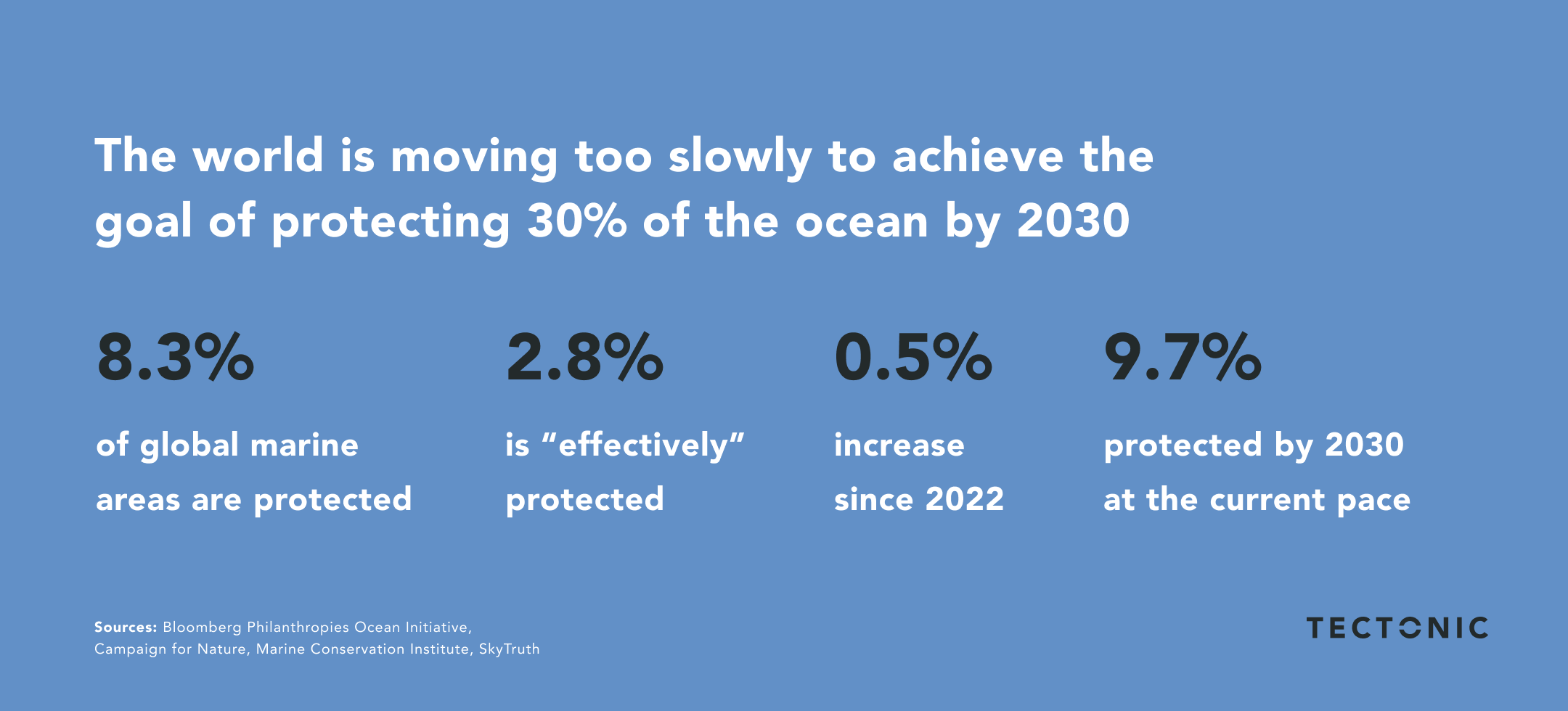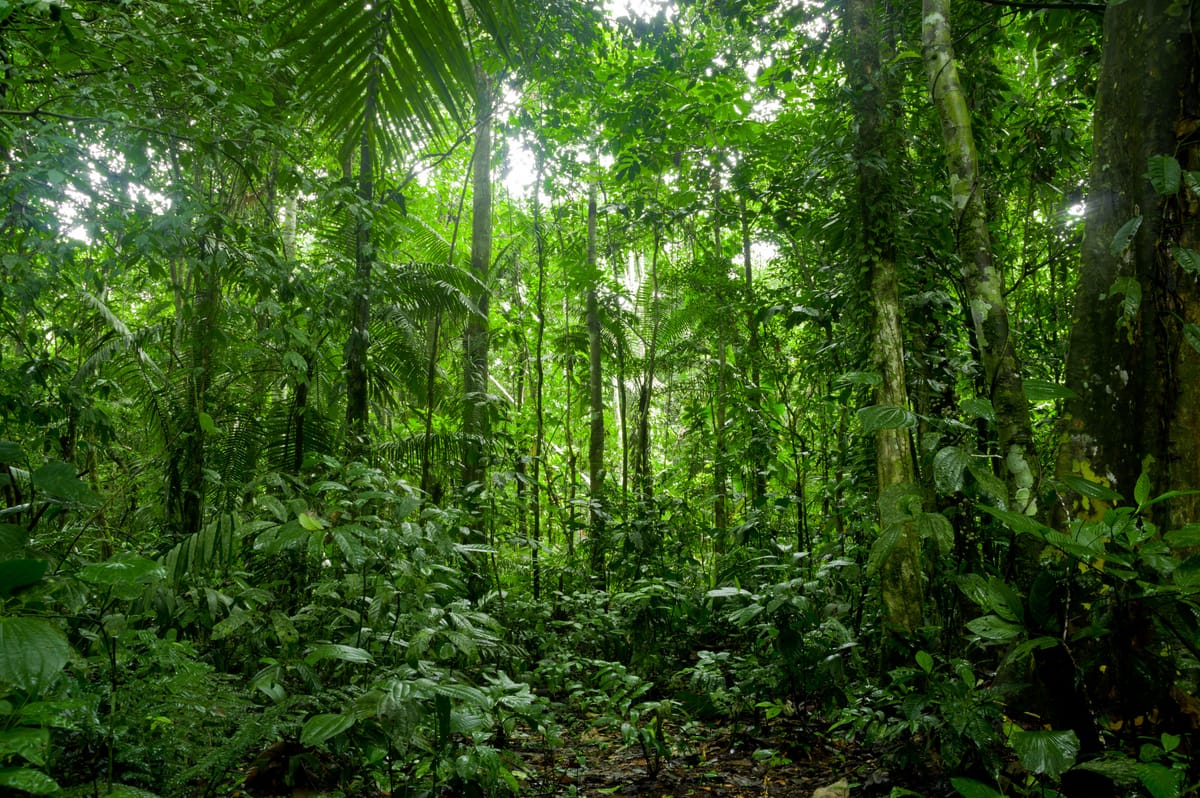This week, leaders are meeting in Cali, Colombia for the COP16 biodiversity conference. While biodiversity-related funding has met a target set in 2022, this week's brief examines the huge gaps in nature financing, conservation, and climate action, and what countries like Brazil are doing to preserve critical ecosystems.
Climate Camp onboard the Peace Boat: Last week, Tectonic cohosted Climate Camp with Peace Boat US. The halfday summit, held onboard the Peace Boat while it was docked in New York Harbor, brought together more than 250 guests and speakers, including a cross-sector community of Ambassadors and artists, investors and innovators, and climate leaders. Conversations ranged from protecting and restoring the ocean to advancing material innovation to unlocking blended capital to invest in people and the planet. Learn more about the Peace Boat and support its mission here.


Leaders meet in Cali, Colombia for COP16: The United Nations is holding its largest biodiversity conference in history, COP16, in Cali, Colombia, with representatives from more than 175 countries in attendance. The conference aims to address the drastic losses of biodiversity, occurring faster than at any time in human history with an estimated one million species in danger of extinction. The conference follows a landmark agreement reached in Montreal two years ago, which set a goal to conserve 30% of the planet's land, inland waters, and oceans, known as the 30x30 target. In Montreal, countries agreed to mobilize $200 billion per year by 2030, but a biodiversity finance gap of $700 billion per year remains, with some of this gap potentially being met by phasing out $500 billion per year in subsidies that are harmful to nature. Yet, a United Nations report found environmentally harmful subsidies actually increased by 55% to $1.7 trillion from 2021 to 2022, driven by support for fossil fuel consumption.
“There is a worrying gap between what was promised in Montreal and the plans put in place so far to reverse the loss of nature by 2030.” — Bernadette Fischler Hooper, World Wide Fund for Nature head of global advocacy
Report outlines financial flows into biodiversity: A report by BloombergNEF outlined biodiversity-related finance has increased to approximately $208 billion per year, up from $166 billion three years ago, surpassing the 2030 biodiversity funding target set by governments at COP15. However, this amount is still a tiny fraction of the $7 trillion invested in "nature-negative" activities annually, according to the UN Environment Programme, and BNEF suggests the target for biodiversity finance should be more than $1.15 trillion.
Behind schedule on marine protection: The monthly update from the Blue Climate Collective – Tectonic's network of 75+ startups advancing ocean-based climate solutions – outlined the status of the global goal set in 2022 to protect 30% of the ocean by 2030. While marine protected areas have been shown to increase fish abundance and biomass, only 8.3% of the ocean is currently protected, and 2.8% is fully or highly protected. At the current pace of added protections since 2022, only 9.7% of the ocean will be protected by the end of the decade. Meanwhile, more than 90% of global fish stocks being fully exploited or overfished, and marine biodiversity is plummeting, including a 70% decline in shark and ray populations over the past 50 years. Advances in securing a High Seas treaty and financing models like the Global Biodiversity Framework Fund offer opportunities to accelerate protection.

UN report says countries made essentially no progress on cutting emissions: The United Nations released its annual Emissions Gap Report which assesses the progress made by countries in reducing greenhouse gas emissions and tackling global warming. The report found that essentially no progress has been made over the past year. Greenhouse gas emissions reached a record 57 gigatons last year and are not expected to decline significantly this decade, making it unlikely that countries will meet the goals set in the 2015 Paris Agreement to limit global warming. The report found that even if all countries follow through on their current plans to curb emissions by 2030, global emissions would only be 3-11% lower than they are today, resulting in a global temperature increase of 2.6-2.8 degrees Celsius (4.7-5 degrees Fahrenheit) above preindustrial levels by the end of the century.
Slowing deforestation in Brazil: More than one-fifth of Brazil’s rainforest has already vanished, but the country has made significant progress in slowing deforestation in the Amazon region, cutting it in half in 2023 compared to the previous year and reaching its lowest level since 2018. This is partly due to the efforts of the Amazon Fund. Launched initially by President Luiz Inacio Lula da Silva in 2008 and relaunched in 2023, the fund promotes sustainable micro-economies that don't damage the rainforest. Totaling around $710 million with contributions from Norway, Germany, Japan, the UK, and the US, the fund aims to mitigate the main drivers of deforestation, including commercial soybean production and cattle ranches, subsistence farmers who burn down sections of the forest to plant crops, and criminal activities such as illegal logging, mining, and trafficking in endangered animals. The government also plans to launch a platform to increase transparency and traceability in the cattle industry to curb deforestation by ranchers.
Researchers discover vast lithium reserves in Arkansas: Researchers from the US Geological Survey and the Arkansas government have discovered a significant amount of lithium, a crucial component for electric vehicle batteries, in an underground brine reservoir in Arkansas. The estimated lithium reserves range from 5 to 19 million tons, which is more than enough to meet the world's demand for the metal. Several companies, including Exxon Mobil, are developing projects to produce lithium from the underground brine. The federal government also approved a large new lithium mine in Nevada and extended tax breaks to some miners to boost the nation’s capacity compared to China. With a $700M loan, the Rhyolite Ridge project would quadruple US lithium production when it's completed in 2028. Meanwhile, companies are exploring cleaner methods to extract lithium, including direct lithium extraction (DLE) technology that can significantly reduce the time it takes to extract lithium from brine from as long as 18 months to a matter of days or hours. However, the process still faces technical challenges, including low recovery rates, high capital costs, and varying sustainability credentials.
Art museums work to reduce their carbon footprint: Museums, galleries, and other art institutions are looking to reduce their environmental footprints. The Hammer Museum's show "Breath(e) Toward Climate and Social Justice" features artworks that address the climate crisis while also considering the exhibition's environmental impact. The exhibition's curators worked to reduce carbon emissions by shipping art items by ground or sea instead of air and printing the exhibition catalog on FSC paper with sustainable forestry practices. Museums are also taking steps to reduce their energy consumption, such as replacing incandescent lightbulbs with LED lighting and investing in solar panels. The Nevada Museum of Art is a notable example. The museum anticipates a 19% reduction in emissions after installing solar panels and has planned a major environmental exhibition featuring over 190 artists. The Gallery Climate Coalition, a group of 1,500 arts-related organizations worldwide, aims to reduce the industry's greenhouse gas emissions by 50 percent by 2030 and has introduced a carbon calculator to help museums and galleries track and reduce carbon emissions.
Tesla profits off battery sales and regulatory credits: Tesla's shares surged 22% after the company reported a 17% increase in profits for the third quarter. Much of Tesla's strong performance came from non-vehicle sales, including a 52% jump in storage battery sales and a 29% increase in revenue from services like charging. The company also made $739 million from selling regulatory credits to other automakers, a 33% increase from a year earlier. The company faces stiff competition in China from domestic automakers like BYD. In Europe, Tesla and other carmakers have suffered from a slowdown in electric car sales after countries cut financial incentives for buyers.
Morgan Stanley strikes deal on direct air capture: Morgan Stanley has entered into a deal with Climeworks AG to finance the removal of 40,000 tons of CO2 from the atmosphere through direct air capture technology in a contract running through 2037. The agreement is intended to help finance Climeworks' expansion in the US and will provide Morgan Stanley with a sizable volume of carbon removal credits. Climeworks operates the world's largest direct air capture project, though efforts will need to scale significantly, with researchers estimating the world will need to remove up to 10 billion tons of planet-warming gases annually by 2050.
The World Bank to increase agriculture investment: The World Bank President Ajay Banga announced plans to double agriculture funding to $9 billion annually by the end of the decade to transform the agriculture sector amidst climate risks and emerging job gaps in the developing world. The bank also aims to mobilize businesses to increase investments in the sector to $5 billion by 2030, leveraging new tools that enable private capital to flow into agriculture. The agriculture sector is increasingly vulnerable to climate risks and is a major driver of emissions. Still, climate-smart production practices can lead to fewer emissions and cleaner air, ultimately improving the quality of life as agricultural productivity increases.


